Xuan Zhao
Data Synthesis with Diverse Styles for Face Recognition via 3DMM-Guided Diffusion
Apr 01, 2025Abstract:Identity-preserving face synthesis aims to generate synthetic face images of virtual subjects that can substitute real-world data for training face recognition models. While prior arts strive to create images with consistent identities and diverse styles, they face a trade-off between them. Identifying their limitation of treating style variation as subject-agnostic and observing that real-world persons actually have distinct, subject-specific styles, this paper introduces MorphFace, a diffusion-based face generator. The generator learns fine-grained facial styles, e.g., shape, pose and expression, from the renderings of a 3D morphable model (3DMM). It also learns identities from an off-the-shelf recognition model. To create virtual faces, the generator is conditioned on novel identities of unlabeled synthetic faces, and novel styles that are statistically sampled from a real-world prior distribution. The sampling especially accounts for both intra-subject variation and subject distinctiveness. A context blending strategy is employed to enhance the generator's responsiveness to identity and style conditions. Extensive experiments show that MorphFace outperforms the best prior arts in face recognition efficacy.
CHOrD: Generation of Collision-Free, House-Scale, and Organized Digital Twins for 3D Indoor Scenes with Controllable Floor Plans and Optimal Layouts
Mar 15, 2025Abstract:We introduce CHOrD, a novel framework for scalable synthesis of 3D indoor scenes, designed to create house-scale, collision-free, and hierarchically structured indoor digital twins. In contrast to existing methods that directly synthesize the scene layout as a scene graph or object list, CHOrD incorporates a 2D image-based intermediate layout representation, enabling effective prevention of collision artifacts by successfully capturing them as out-of-distribution (OOD) scenarios during generation. Furthermore, unlike existing methods, CHOrD is capable of generating scene layouts that adhere to complex floor plans with multi-modal controls, enabling the creation of coherent, house-wide layouts robust to both geometric and semantic variations in room structures. Additionally, we propose a novel dataset with expanded coverage of household items and room configurations, as well as significantly improved data quality. CHOrD demonstrates state-of-the-art performance on both the 3D-FRONT and our proposed datasets, delivering photorealistic, spatially coherent indoor scene synthesis adaptable to arbitrary floor plan variations.
X-IL: Exploring the Design Space of Imitation Learning Policies
Feb 19, 2025Abstract:Designing modern imitation learning (IL) policies requires making numerous decisions, including the selection of feature encoding, architecture, policy representation, and more. As the field rapidly advances, the range of available options continues to grow, creating a vast and largely unexplored design space for IL policies. In this work, we present X-IL, an accessible open-source framework designed to systematically explore this design space. The framework's modular design enables seamless swapping of policy components, such as backbones (e.g., Transformer, Mamba, xLSTM) and policy optimization techniques (e.g., Score-matching, Flow-matching). This flexibility facilitates comprehensive experimentation and has led to the discovery of novel policy configurations that outperform existing methods on recent robot learning benchmarks. Our experiments demonstrate not only significant performance gains but also provide valuable insights into the strengths and weaknesses of various design choices. This study serves as both a practical reference for practitioners and a foundation for guiding future research in imitation learning.
Enhancing Fairness through Reweighting: A Path to Attain the Sufficiency Rule
Aug 26, 2024

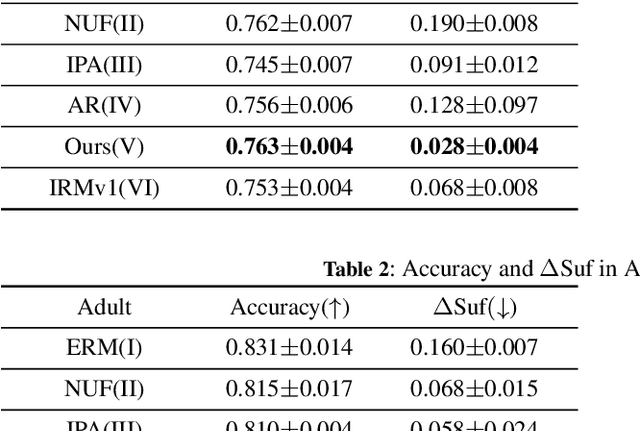

Abstract:We introduce an innovative approach to enhancing the empirical risk minimization (ERM) process in model training through a refined reweighting scheme of the training data to enhance fairness. This scheme aims to uphold the sufficiency rule in fairness by ensuring that optimal predictors maintain consistency across diverse sub-groups. We employ a bilevel formulation to address this challenge, wherein we explore sample reweighting strategies. Unlike conventional methods that hinge on model size, our formulation bases generalization complexity on the space of sample weights. We discretize the weights to improve training speed. Empirical validation of our method showcases its effectiveness and robustness, revealing a consistent improvement in the balance between prediction performance and fairness metrics across various experiments.
Sunnie: An Anthropomorphic LLM-Based Conversational Agent for Mental Well-Being Activity Recommendation
May 22, 2024



Abstract:A longstanding challenge in mental well-being support is the reluctance of people to adopt psychologically beneficial activities, often due to a lack of motivation, low perceived trustworthiness, and limited personalization of recommendations. Chatbots have shown promise in promoting positive mental health practices, yet their rigid interaction flows and less human-like conversational experiences present significant limitations. In this work, we explore whether the anthropomorphic design (both LLM's persona design and conversational experience design) can enhance users' perception of the system and their willingness to adopt mental well-being activity recommendations. To this end, we introduce Sunnie, an anthropomorphic LLM-based conversational agent designed to offer personalized guidance for mental well-being support through multi-turn conversation and activity recommendations based on positive psychological theory. An empirical user study comparing the user experience with Sunnie and with a traditional survey-based activity recommendation system suggests that the anthropomorphic characteristics of Sunnie significantly enhance users' perception of the system and the overall usability; nevertheless, users' willingness to adopt activity recommendations did not change significantly.
Discovering Galaxy Features via Dataset Distillation
Nov 29, 2023Abstract:In many applications, Neural Nets (NNs) have classification performance on par or even exceeding human capacity. Moreover, it is likely that NNs leverage underlying features that might differ from those humans perceive to classify. Can we "reverse-engineer" pertinent features to enhance our scientific understanding? Here, we apply this idea to the notoriously difficult task of galaxy classification: NNs have reached high performance for this task, but what does a neural net (NN) "see" when it classifies galaxies? Are there morphological features that the human eye might overlook that could help with the task and provide new insights? Can we visualize tracers of early evolution, or additionally incorporated spectral data? We present a novel way to summarize and visualize galaxy morphology through the lens of neural networks, leveraging Dataset Distillation, a recent deep-learning methodology with the primary objective to distill knowledge from a large dataset and condense it into a compact synthetic dataset, such that a model trained on this synthetic dataset achieves performance comparable to a model trained on the full dataset. We curate a class-balanced, medium-size high-confidence version of the Galaxy Zoo 2 dataset, and proceed with dataset distillation from our accurate NN-classifier to create synthesized prototypical images of galaxy morphological features, demonstrating its effectiveness. Of independent interest, we introduce a self-adaptive version of the state-of-the-art Matching Trajectory algorithm to automate the distillation process, and show enhanced performance on computer vision benchmarks.
Counterfactual Explanation for Regression via Disentanglement in Latent Space
Nov 23, 2023



Abstract:Counterfactual Explanations (CEs) help address the question: How can the factors that influence the prediction of a predictive model be changed to achieve a more favorable outcome from a user's perspective? Thus, they bear the potential to guide the user's interaction with AI systems since they represent easy-to-understand explanations. To be applicable, CEs need to be realistic and actionable. In the literature, various methods have been proposed to generate CEs. However, the majority of research on CEs focuses on classification problems where questions like "What should I do to get my rejected loan approved?" are raised. In practice, answering questions like "What should I do to increase my salary?" are of a more regressive nature. In this paper, we introduce a novel method to generate CEs for a pre-trained regressor by first disentangling the label-relevant from the label-irrelevant dimensions in the latent space. CEs are then generated by combining the label-irrelevant dimensions and the predefined output. The intuition behind this approach is that the ideal counterfactual search should focus on the label-irrelevant characteristics of the input and suggest changes toward target-relevant characteristics. Searching in the latent space could help achieve this goal. We show that our method maintains the characteristics of the query sample during the counterfactual search. In various experiments, we demonstrate that the proposed method is competitive based on different quality measures on image and tabular datasets in regression problem settings. It efficiently returns results closer to the original data manifold compared to three state-of-the-art methods, which is essential for realistic high-dimensional machine learning applications. Our code will be made available as an open-source package upon the publication of this work.
Adversarial Reweighting Guided by Wasserstein Distance for Bias Mitigation
Nov 21, 2023



Abstract:The unequal representation of different groups in a sample population can lead to discrimination of minority groups when machine learning models make automated decisions. To address these issues, fairness-aware machine learning jointly optimizes two (or more) metrics aiming at predictive effectiveness and low unfairness. However, the inherent under-representation of minorities in the data makes the disparate treatment of subpopulations less noticeable and difficult to deal with during learning. In this paper, we propose a novel adversarial reweighting method to address such \emph{representation bias}. To balance the data distribution between the majority and the minority groups, our approach deemphasizes samples from the majority group. To minimize empirical risk, our method prefers samples from the majority group that are close to the minority group as evaluated by the Wasserstein distance. Our theoretical analysis shows the effectiveness of our adversarial reweighting approach. Experiments demonstrate that our approach mitigates bias without sacrificing classification accuracy, outperforming related state-of-the-art methods on image and tabular benchmark datasets.
Causal Fairness-Guided Dataset Reweighting using Neural Networks
Nov 17, 2023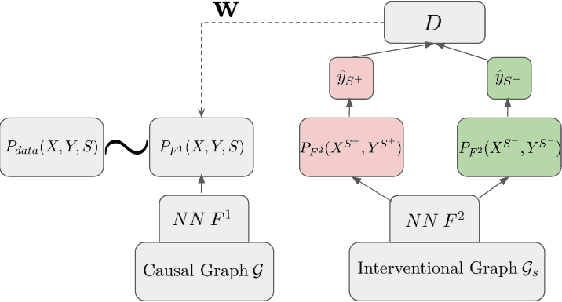
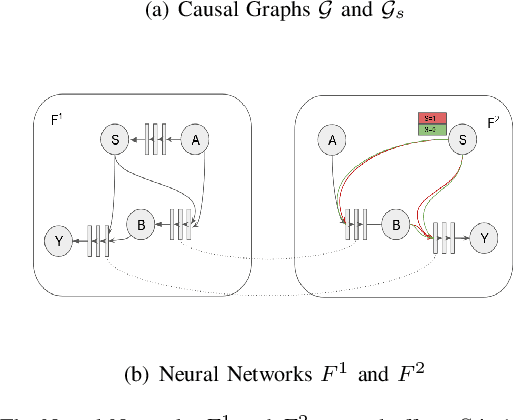
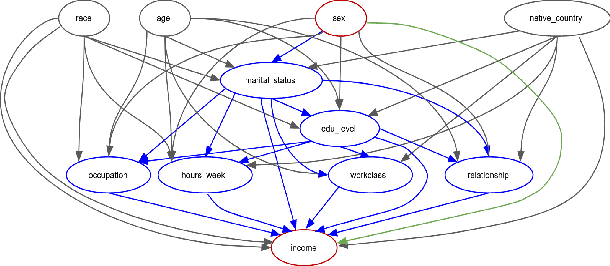
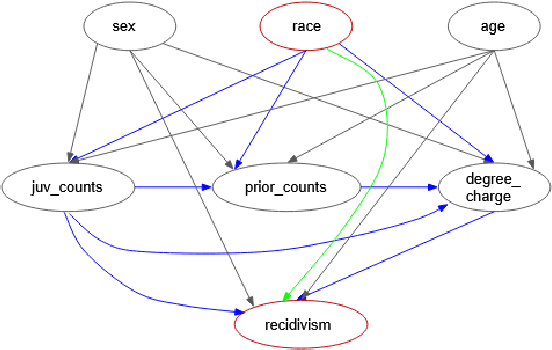
Abstract:The importance of achieving fairness in machine learning models cannot be overstated. Recent research has pointed out that fairness should be examined from a causal perspective, and several fairness notions based on the on Pearl's causal framework have been proposed. In this paper, we construct a reweighting scheme of datasets to address causal fairness. Our approach aims at mitigating bias by considering the causal relationships among variables and incorporating them into the reweighting process. The proposed method adopts two neural networks, whose structures are intentionally used to reflect the structures of a causal graph and of an interventional graph. The two neural networks can approximate the causal model of the data, and the causal model of interventions. Furthermore, reweighting guided by a discriminator is applied to achieve various fairness notions. Experiments on real-world datasets show that our method can achieve causal fairness on the data while remaining close to the original data for downstream tasks.
Counterfactual Explanation via Search in Gaussian Mixture Distributed Latent Space
Jul 25, 2023



Abstract:Counterfactual Explanations (CEs) are an important tool in Algorithmic Recourse for addressing two questions: 1. What are the crucial factors that led to an automated prediction/decision? 2. How can these factors be changed to achieve a more favorable outcome from a user's perspective? Thus, guiding the user's interaction with AI systems by proposing easy-to-understand explanations and easy-to-attain feasible changes is essential for the trustworthy adoption and long-term acceptance of AI systems. In the literature, various methods have been proposed to generate CEs, and different quality measures have been suggested to evaluate these methods. However, the generation of CEs is usually computationally expensive, and the resulting suggestions are unrealistic and thus non-actionable. In this paper, we introduce a new method to generate CEs for a pre-trained binary classifier by first shaping the latent space of an autoencoder to be a mixture of Gaussian distributions. CEs are then generated in latent space by linear interpolation between the query sample and the centroid of the target class. We show that our method maintains the characteristics of the input sample during the counterfactual search. In various experiments, we show that the proposed method is competitive based on different quality measures on image and tabular datasets -- efficiently returns results that are closer to the original data manifold compared to three state-of-the-art methods, which are essential for realistic high-dimensional machine learning applications.
 Add to Chrome
Add to Chrome Add to Firefox
Add to Firefox Add to Edge
Add to Edge